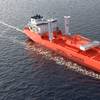Complying with emission rules and regulations is hardly a new topic to the engineers at Cummins Engine Co. Cummins has a long and successful history serving the more stringent automotive and industrial markets, boasting more than 25 years experience designing engines that meet demanding emission parameters and provide efficient, reliable performance.
According to Conrad, with the January 1, 2000 deadline looming for compliance with new IMO standards regarding NOx emissions (see related story, page 74), Cummins is prepared to support its customers by having a full range of IMO compliant engines available in countries covered by the IMO treaty. While
Conrad admits that this has presented some challenges, he said the task was made simpler since the U.S. Environmental Protection Agency (EPA) has regulated emissions in other diesel markets since 1992. Product upgrades are already underway at Cummins to meet these more stringent restrictions through an increased use of electronics, advance air handling techniques and other modifications. The manufacturer's commitment is substantiated by the fact that, according to Cartwright, 75 percent of test cell time (currently) is spent on the legislative side of emissions, a measure taken to ensure that the entire product line-up will be compliant with IMO regs by the end of 1999.
While the responsibility is on the vessel owner operator to prove a propulsion package's compliance, Conrad believes it is smart planning to arm customers with the necessary technical documentation. "It is our position at Cummins that we should protect our customers in regard to the MARPOL 73/78 regulations, including proper engine documentation in addition to the Lloyds Registry certification. At the same time we will continue to offer the same wide range of horsepower with the quality products that have earned us a growing stake in the worldwide marine market."
And while marine players have been hit with a seeming barrage of rules and regulations regarding operational parameters in recent year, Cartwright notes that the marine industry is a good 25 years behind the automotive world. But it will soon change. "The interesting thing in the marine world, is that we will very quickly catch up to the automotive side in terms of emission level, by 20 1 0 we may be only a few years behind, versus now 25 years.
In fact, engine line production and enhancement will be significantly stepped-up in the new century, as Cartwright and company plan for compliance with future regulations. He said that advances in low temperature after-cooling and electronic control, in particular will be important to comply with next generation, EPA-driven requirements, that will potentially incorporate NOx, particulates and CO, as well as potentially noise.
Sponsored Content
Lower carbon intensity fuels to support your operations

Subscribe for
Maritime Reporter E-News
Maritime Reporter E-News is the maritime industry's largest circulation and most authoritative ENews Service, delivered to your Email five times per week










